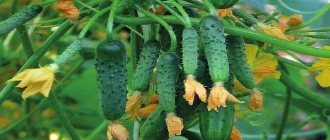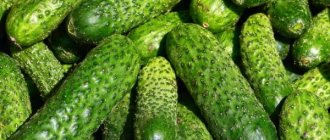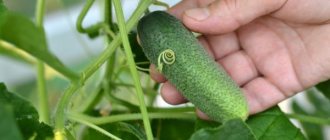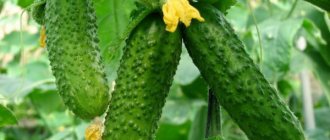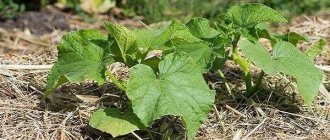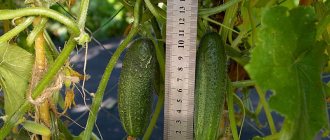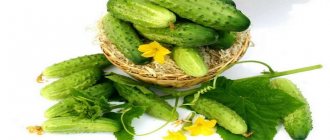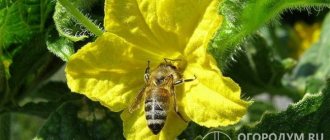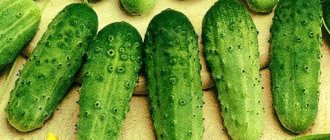Vegetable growing » Cucumbers
0
2489
Article rating
Kira Stoletova
Cucumbers are rightfully one of the most popular vegetable crops. The fruits of these plants can be eaten raw or canned for the winter. The Monastyrsky cucumber variety attracts agronomists with its taste and long shelf life.
Characteristics of cucumbers of the Monastyrsky variety
The variety is resistant to common diseases. The strength of the fruits allows them to be transported over long distances.
Direct seeding method
With the seedless method of growing “monastic” cucumber, seeds are sown only when the soil warms up to at least 15 degrees. At lower temperatures, the seeds die. The seeding depth is about 2 cm, sowing density is up to 7 plants per square meter. Ideally, it is recommended to sow seeds more often and thin them after germination.
When sowing “monastic” cucumbers, it is worth considering that the variety is bee-pollinated. Because of this feature, it is recommended to sow together with other varieties, which increases yield.
Landing
Seeds are sown for seedlings 25-30 days before transferring to the garden bed. You can transplant bushes into the ground when its temperature is consistently at least +15 (usually in the middle or end of May). Seeds are sown directly into the beds, also at the end of May or June.
For cucumbers, prepare a sunny, wind-protected area, best after potatoes, tomatoes, peppers, cabbage or legumes. They dig it up and add at least a bucket of organic fertilizer (compost, manure) per square meter. You can add wood ash and a little superphosphate or ammonium nitrate.
Seeds are sown in holes or furrows at the rate of 3-5 plants per 1 square meter. m. Before planting, you can treat them with a weak solution of potassium permanganate, then rinse and soak in a stimulant solution, and then germinate in a warm place.
Seedlings are grown in peat pots on a sunny windowsill. Before germination, it is provided with heat, after which the temperature is reduced to +18-20 so that the sprouts do not stretch.
Features of soil preparation
The soil for cucumbers should be loose, fertile and retain moisture well. When growing cucumbers of the “monastic” variety, it is recommended to apply organic fertilizers directly into the planting hole. This is due to the peculiarity of the root system of the crop.
Before sowing or planting seedlings, you should dig a trench at least 40 cm deep. Organic matter is laid out at its bottom and mixed with the lower layers of the soil. Clean soil without impurities is poured on top. During the process of decay, organic matter will release heat and warm the plants from below. This accelerates the growth and development of the bushes, and will then serve as an excellent top dressing.
Temperature
The most optimal temperature for growing cucumbers is 25-30 degrees. At the same time, at night the air temperature should not fall below 15 degrees. Otherwise, this can lead to inhibition and complete stop of plant growth at any stage of its development. Frosts are destructive for the crop. They not only hinder their growth, but can also completely destroy them. Due to the fact that late frosts often occur in the central part of the country and its northern regions, the crop is grown under film covers in greenhouses.
Reviews of varieties from summer residents
Reviews from gardeners who decided to plant various hybrids of cucumbers on their plot.
Valentina, 51 years old
“We recently bought a plot of land and immediately the idea arose that we would start growing vegetables. There were also cucumbers. My sister advised me to buy the Ladies' Caprice variety. The cucumbers grew very tasty and crispy. Suitable for pickles. I was satisfied with the variety.”
“I used to buy a hybrid Miracle Bouquet. The vegetables grew quite well, but I was not delighted with them. Then I switched to the Harmony variety. I really liked the cucumbers. We ate them all summer and made salads from them. Now this is my favorite variety.”
Features of care
According to reviews, the “monastery” cucumber needs pinching. This procedure involves removing all side shoots and ovaries growing up to the fourth leaf of the young bush. Pinching helps develop a healthy, strong root system.
The plant branches well. If necessary, you can pinch the top. As a result of this procedure, independent branching begins to develop, and only male flowers appear on the main stem.
Some vegetable growers pinch side shoots after the second ovary. However, not all summer residents agree with this opinion.
It is easy to distinguish a male flower from a female one. The latter initially contains a small cucumber, which is visible. Male flowers do not have such formations.
Description and characteristics of the variety
Monastyrskie cucumbers are a mid-season bee-pollinated variety intended for cultivation in open and protected ground:
- The plant is indeterminate, medium size, mixed flowering.
- The location of the ovary on nodes 2-4 does not allow them to outgrow.
Beautiful, equal-sized greens are formed:
- Zelenets has the shape of a cylinder, dark green with light stripes
- 6-10 cm long, weighing 90-100 grams.
- After preservation and salting it remains crispy. Cucumber is also widely used for fresh consumption.
Features of watering
During the active growth stage, it is important to maintain humidity levels. Even when the soil dries out for a short time, bitterness appears in the plant. It is impossible to remove it even with abundant watering. To prevent this from happening, it is necessary to water the cucumbers with warm, settled water every day, and in dry, hot weather - twice a day.
Mulching helps retain soil moisture. Any organic material is suitable for this, even grass from the garden. Mulch helps protect the soil in the garden bed from drying out and prevents the growth of weeds, which will save time on caring for bushes and reduce the frequency of watering.
Frequent watering compacts the soil. To allow air to pass through it to the roots, loosening is necessary. Punctures are made to a depth of at least 10 centimeters.
How to distinguish pickling cucumber varieties from salad varieties?
White Mouse
Don't know. I never buy huge salad “bast shoes”. I always take selected cucumbers with pimples. For salting it is generally the size of a little finger. I seal them in maximum liter jars. They crunch and are very sharp, small and beautiful to look at and tasty.
Darina is a miracle gift
It is easy to distinguish pickling cucumbers from salad cucumbers even by appearance - the most lumpy ones with complex black pubescence are the pickling ones. Just pay attention to the thorns - the white-thorned (salad) thorns do not turn yellow on the bush for a long time, they have a thick peel (not permeable to sodium chloride solution). These are not suitable for pickles (but they are tasty in salads). but with black spikes – that’s it!
The spines on the fruit regulate the evaporation of moisture. The spines darken due to the pigment - flavonin, which gradually accumulates, turns black and stops the evaporating activity of the spine, making it brittle. The pigment then spreads along the walls of the surface cells of the epidermis of the fruit, which inhibits the flow of brine into the cucumber pulp.
The pickling qualities also depend on the density and pulp of the fruit - in a pickled cucumber it is much denser. In large-tuberous pickling varieties, transverse vascular bundles approaching the surface of the fruit are highly developed, which makes the flesh crispy.
The quality of pickling also depends on the surface of the fruit. When packed tightly in barrels, the surface of the lumpy cucumbers provides better flow of brine.
Fertilizer application
To get the same “monastery” cucumber as in the photo, you need to apply fertilizer in a timely manner. Proper fertilizing not only increases the yield, but also prolongs fruiting.
When applying fertilizers, it is important to ensure that the working solutions do not get on the leaves or stems of the plant. You should not apply nutrients in cold weather, as it causes the plant to grow slower and the root system cannot absorb the nutrients.
Lack of nutrients leads to impaired plant growth and causes deformation of the fruit. To avoid this, it is recommended to fertilize once a season with a complex mineral fertilizer containing nitrogen, magnesium and potassium. You can also periodically use onion infusion for watering (pour two handfuls of peels into five liters of water and leave for three days), fermented milk products (dilute a liter of whey in five liters of water), and chicken droppings (dilute two hundred grams of droppings in a bucket of water). Organic fertilizers attract pests. Therefore, they should be excluded if the area is infected with spider mites or whiteflies.
Diseases, plant pests
According to the description of the variety, “monastery” cucumbers have excellent resistance to common diseases. But even this does not guarantee that the crop will not be affected by fungi and viruses. To avoid this, it is recommended to carry out disease prevention at least once during the entire growing season. To do this, use any preparations available in the garden store.
Timely watering, harvesting, fertilizing, pinching will help to get a good harvest of greens with excellent taste.
Varieties of cucumbers for pickling: the opinion of residents of the Moscow region
What varieties of cucumbers do residents of the Moscow region grow?
The taste preferences of summer residents and their family members influence which variety of cucumbers they choose for planting. Residents of the Moscow region prefer to grow vegetables for salads and those that will be eaten. They believe that all varieties of pickling cucumbers must grow actively in open ground, otherwise “explosions” cannot be avoided; in a cellar or pantry, when the sealing lids cannot withstand the pressure of gases inside the glass jar. The greenhouse pimply friend for salads is good on the table, but not in transparent “packaging”.
What determines the pickling qualities of vegetables?
First of all, on the variety of cucumbers for pickling. Some amateurs believe that black “spikes” vegetables speak of its excellent qualities for canning. They are wrong, since the thickness of the skin and the density of the pulp are the main indicators that the barrel can be cooked. Sugar and pectin substances also play an important role when processing cucumbers, but this indicator is unlikely to be measured by an ordinary summer resident.
What varieties of cucumbers are ideal for pickling?
Those with thin skin. Slice the cucumber crosswise and you will see for yourself. Although recently they have been selling universal varieties, which are not a sin to have dinner with, or to douse with hot brine. The packaging with seeds must indicate what kind of processing the cucumber grown from them is subject to. When purchasing cucumber seeds for pickling, be sure to ask the seller which ones are for greenhouses and which ones are for open ground.
What do owners of private houses in the Moscow region plant in their garden beds?
Naturally, hybrid varieties of cucumbers for pickling, and even the rating was based on them:
- Masha comes first. It manages to ripen not only in 36 days, but has a small-sized fruit in the form of a regular cylinder, with pronounced tubercles, with minimal bitterness. Goes great in pickling.
- Murashka confidently holds second place. It was created by breeders from the agricultural company Gavrosh9raquo;. After 45 days, you can prepare jars, since one bush produces at least seven kilograms of green fruits, which are easy to preserve. Its thorns are truly black, so in winter the family will enjoy not only the excellent taste of pickled cucumbers, but also feel how they tingle the tongue.
- Two hybrids took third place: Zyatek and Herman. The second variety has rather large tubercles, but in a barrel or bucket this variety looks great with a length of no more than 7 cm. Zyatek let us down a little. Its spines are whitish, so it is suitable not for storage in canned form, but as a lightly salted option. You can’t find a better complement to young potatoes and streaky lard than a crispy “relative”.
What varieties of pickling cucumbers are in the top ten?
- In fourth place is Rodnichok. Suitable for salads and under the lid. This variety would have been happily cooked in honey by the cooks of Peter I, who knew a lot about delicacies of the 18th century.
- The fifth level of honor goes to Libella. This vegetable arrived in Russia from Germany and firmly established itself in the garden beds, like the famous Kukuyskaya Settlement in boyar Moscow.
- The remaining places were taken by Izyashny, Nezhinsky, Konkurent, Muromsky and Monastyrsky. These are the best varieties of Russian pickling cucumbers, although their rating is not as high as those mentioned above. Unfortunately, their yield depends on weather conditions, which constantly surprise us.
